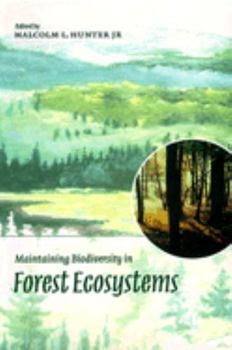Maintaining Biodiversity in Forest Ecosystems
Select Format
Select Condition 
Book Overview
The maintenance of the earth's biological diversity is widely seen as both necessary for ecosystem health and aesthetically desirable. This book focuses on how biodiversity can be maintained in forested ecosystems, particularly in those forests that are subject to timber harvesting. At the core of the book lies the concept that diversity should be conserved in all its forms--from the smallest microbes to the largest trees, and at all levels of organization--from genes to whole ecosystems. Introductory chapters on biodiversity and ecological forestry lead on to sections dealing with management at the macro (landscape) and micro (stand) levels. A concluding section addresses socioeconomic considerations that round out an overall synthesis and framework for the implementation of successful management practices. Thirty-three experts from ten countries contribute to this thorough and comprehensive account, providing a broad-based perspective that will be of interest internationally to researchers and professsionals in conservation, forestry, and ecology.
Format:Paperback
Language:English
ISBN:0521637686
ISBN13:9780521637688
Release Date:September 2000
Publisher:Cambridge University Press
Length:716 Pages
Weight:2.65 lbs.
Dimensions:1.5" x 6.2" x 9.3"
Customer Reviews
1 rating
A marvelous synthesis
Published by Thriftbooks.com User , 23 years ago
Malcolm Hunter provided the first accessible, operational synthesis of landscape ecology, wildlife biology, and forestry in his "Wildlife, Forests, and Forestry." That book has proven indispensable for me during my career as a forest wildlife biologist. "Maintaining Biodiversity in Forest Ecosystems" is even better.In the Foreword, Jack Ward Thomas says that he wishes that he had written this book. I wish I could write like these authors! The editing is first-class and a joy to read. Given the list of contributors, how could you lose? The organization is also quite logical, with papers organized into landscape- and stand-level topics.For those of you who like to know what you're buying, here are the authors and their contributions (all of the chapters are excellent): Hunter: Biological diversity // Hunter and Seymour: Principles of ecological forestry // Palik and Engstrom: Species composition // Spies and Turner: Dynamic forest mosaics // Hansen and Rotella: Abiotic factors // Matlack and Litvaitis: Forest edges // Haila: Islands and fragments // Brinson and Verhoeven: Riparian forests // Calhoun: Wetlands // McComb and Lindenmayer: Dying, dead, and down trees // Brokaw and Lent: Vertical structure // Moore and Allen: Plantation forestry // Thompson and Angelstam: Special species // Millar: Genetic diversity // Frelich and Puettman: Restoration ecology // Norton: Forest reserves // Oliver, Boydak, Segura, and Bare: Forest organization, management, and policy // Lippke and Bishop: The economic perspective // Maguire: Social perspectives //This book is borrowed more often than any of the others in my collection. What else can I say?





